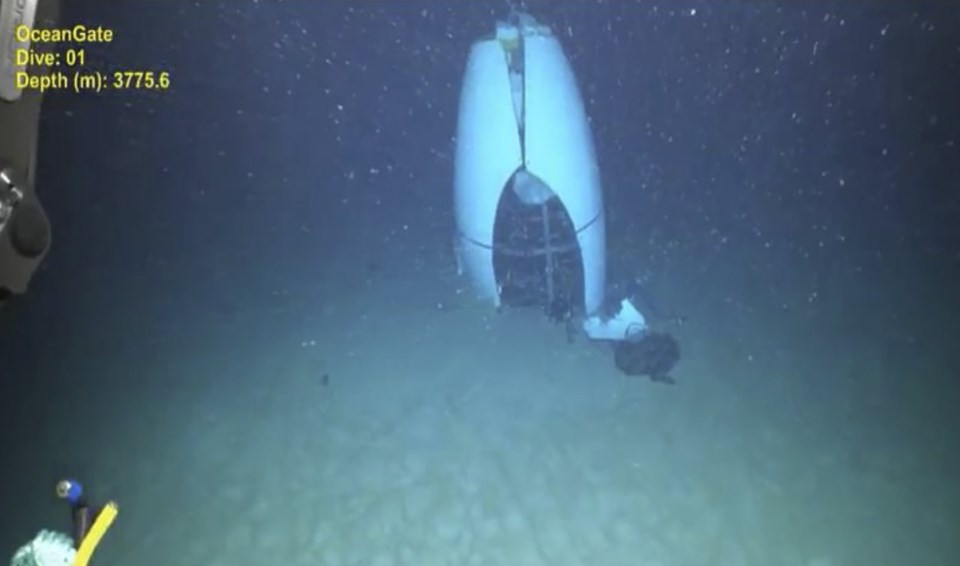The co-founder of the company that owned the en route to the wreckage of the Titanic told a Coast Guard panel Monday that he hoped that the silver lining of the disaster will inspire a renewed interest in exploration, including the deepest waters of the world's oceans.
“This can’t be the end of deep ocean exploration. This can’t be the end of deep-diving submersibles and I don’t believe that it will be,” said businessman Guillermo Sohnlein, who helped found OceanGate with Stockton Rush.
Sohnlein ultimately left the company before the Titan disaster in June 2023. Rush was among the when the submersible imploded. Though Sohnlein left the Washington company years ago, he spoke in defense of its efforts in the aftermath of the submersible’s implosion.
On Monday, he testified that the company wanted to create a fleet of four or five deep-diving submersibles capable of carrying five people to 6,000 meters (6,500 yards) deep. The plan for the company was to have no dedicated mothership — which would've lowered costs substantially, he said.
“We wanted to give humanity greater access to the ocean, specifically the deep ocean,” Sohnlein said.
Sohnlein testified that the company zeroed in on the use of carbon fiber for the doomed vessel because the company wanted a lightweight, less costly submersible that did not need to be tethered to a specific mother ship. He testified that the use of carbon fiber as “not a novel idea” and said “people have looked at that before.”
No existing submersible builders could meet the company’s requirements, necessitating the pivot to building its own subs, Sohnlein said. And he said the company worked closely with the Coast Guard during development.
Sohnlein said he had the opportunity to dive in Titan “many times” and he declined. He said his reasons included not wanting to take space away from potential customers. He said when Rush reached a point when it was “time to put a human in there,” he wanted to do it himself. Rush felt it was his design and said “if anything happens, I want it to impact me,” Sohnlein said.
The Coast Guard opened a public hearing earlier this month that is part of a high level investigation into the cause of the implosion. Some of the testimony has focused on the troubled nature of the company.
, former OceanGate operations director David Lochridge said he frequently clashed with Rush and felt the company was committed only to making money. “The whole idea behind the company was to make money,” Lochridge testified. “There was very little in the way of science.”
But Sohnlein said Monday that neither he nor Rush was ever “driven by tourism” and the idea of visiting the Titanic, which had already been explored by others, was not exciting to either of them.
Sohlein also testified Monday that he left the company in 2013 as the company transitioned to engineering, which he described as a bigger strength of Rush's than his. He said it was a “fairly easy decision” for Rush to take over the company, but it was more difficult to decide whether to stay on at all.
Ultimately, Sohnlein said, he didn't feel it made sense for the company to continue paying him a salary of $120,000 for a reduced role. He said he maintained a minority stake in the company that still exists.
“It just didn't make sense financially to keep paying me that kind of salary when I wasn't going to be doing much other than overseeing business operations,” Sohnlein said, adding that it was “one of the hardest decisions I had to make” and he once thought it was going to be “the last job he ever had.”
The hearing is expected to run through Friday and include more witnesses. Roy Thomas of the American Bureau of Shipping also testified Monday and detailed the challenges associated with carbon fiber as a material for submersibles. He said carbon fiber is "susceptible to fatigue failure under repeated external pressurization."
Former OceanGate engineering director Phil Brooks was also scheduled to testify Monday.
Lochridge and other previous witnesses painted a picture of a troubled company that was impatient to get its into the water. The accident set off a worldwide debate about the future of private undersea exploration.
Coast Guard officials noted at the start of the hearing that the submersible had not been independently reviewed, as is standard practice. That and Titan’s unusual design subjected it to scrutiny in the undersea exploration community.
OceanGate, based in Washington state, suspended its operations after the implosion. The company has no full-time employees currently, but has been during the hearing.
During the submersible’s final dive on June 18, 2023, the crew lost contact after an exchange of texts about Titan’s depth and weight as it descended. The support ship Polar Prince then sent repeated messages asking if Titan could still see the ship on its onboard display.
One of the last messages from Titan’s crew to Polar Prince before the submersible imploded stated, “all good here,” according to a visual re-creation presented earlier in the hearing.
When the submersible was reported overdue, rescuers rushed ships, planes and other equipment to an area about 435 miles (700 kilometers) south of St. John’s, Newfoundland. Wreckage of the Titan was subsequently found on the ocean floor about 330 yards (300 meters) off the bow of the Titanic, Coast Guard officials said. No one on board survived.
OceanGate said it has been fully cooperating with the Coast Guard and NTSB investigations since they began. Titan had been making voyages to the Titanic wreckage site going back to 2021.
Patrick Whittle, The Associated Press


